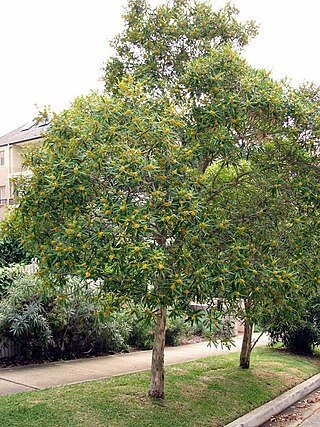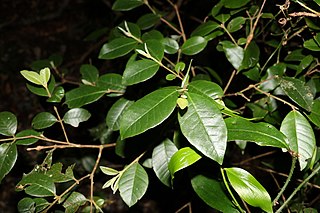
Eucalypt is any woody plant with capsule fruiting bodies belonging to one of seven closely related genera found across Australia: Eucalyptus, Corymbia, Angophora, Stockwellia, Allosyncarpia, Eucalyptopsis and Arillastrum. In Australia, they are commonly known as gum trees or stringybarks.

Myrtaceae, the myrtle family, is a family of dicotyledonous plants placed within the order Myrtales. Myrtle, pōhutukawa, bay rum tree, clove, guava, acca (feijoa), allspice, and eucalyptus are some notable members of this group. All species are woody, contain essential oils, and have flower parts in multiples of four or five. The leaves are evergreen, alternate to mostly opposite, simple, and usually entire. The flowers have a base number of five petals, though in several genera, the petals are minute or absent. The stamens are usually very conspicuous, brightly coloured, and numerous.

Leptospermum is a genus of shrubs and small trees in the myrtle family Myrtaceae commonly known as tea trees, although this name is sometimes also used for some species of Melaleuca. Most species are endemic to Australia, with the greatest diversity in the south of the continent, but some are native to other parts of the world, including New Zealand and Southeast Asia. Leptospermums all have five conspicuous petals and five groups of stamens which alternate with the petals. There is a single style in the centre of the flower and the fruit is a woody capsule.

Metrosideros is a genus of approximately 60 trees, shrubs, and vines in the family Myrtaceae, mostly found in the Pacific region. Most of the tree forms are small, but some are exceptionally large, the New Zealand species in particular. The name derives from the Ancient Greek metra or "heartwood" and sideron or "iron". Perhaps the best-known species are the pōhutukawa, northern rātā and southern rātā of New Zealand, and ʻōhiʻa lehua from the Hawaiian Islands.

Backhousia is a genus of thirteen currently known species of flowering plants in the family Myrtaceae. All the currently known species are endemic to Australia in the rainforests and seasonally dry forests of Queensland, New South Wales and Western Australia.

Lophostemon is a genus of 4 species of evergreen tree in the myrtle family Myrtaceae. All four species are native to Australia, with one extending to New Guinea. The genus was first described in 1830 but not widely recognized until the 1980s. All 4 species were previously included in the related genus Tristania.

Baeckea is a genus of flowering plants in the myrtle family, Myrtaceae, all but one endemic to Australia. Plants in the genus Baeckea are shrubs or small trees with leaves arranged in opposite pairs, white to deep pink flowers with five sepals and five petals, and five to fifteen stamens that are shorter than the petals.

Tristaniopsis is a genus of shrubs and trees in the myrtle family Myrtaceae described as a genus in 1863. They have a wide distribution in Southeast Asia, New Guinea, New Caledonia and Australia.

Chamelaucium, also known as waxflower, is a genus of shrubs endemic to south western Western Australia. They belong to the myrtle family Myrtaceae and have flowers similar to those of the tea-trees (Leptospermum). The most well-known species is the Geraldton wax, Chamelaucium uncinatum, which is cultivated widely for its large attractive flowers.

Lenwebbia is a genus of shrubs or small trees in the myrtle family Myrtaceae. The type species is Lenwebbia lasioclada.
Thaleropia is a genus of flowering plants in the family Myrtaceae first described as a genus in 1993. It is native to Queensland and Papuasia.

Sannantha is a genus of flowering plants in the family Myrtaceae that are native to Australia and New Caledonia. Plants in the genus Sannantha are shrubs or trees with leaves arranged in opposite pairs, flowers usually arranged in small groups, the peduncles often 1.5–2 times as long as the pedicels and with seven to fourteen stamens. The fruit is a thin-walled capsule containing flattened, D-shaped seeds. Some species of Sannantha were previously included in the genus Babingtonia.

Chamelaucieae is a tribe of flowering plants within the family Myrtaceae, mostly from Australia, with a few species in New Caledonia and south-east Asia.
Ristantia is a group of plants in the family Myrtaceae described as a genus in 1982. The entire genus is endemic to the State of Queensland in Australia.
- Ristantia gouldiiPeter G. Wilson & B. Hyland - a tree species listed as vulnerable
- Ristantia pachysperma(F.Muell. & F.M.Bailey) Peter G.Wilson & J.T.Waterh.
- Ristantia waterhouseiPeter G.Wilson & B.Hyland
Kardomia is a genus of flowering plants in the family Myrtaceae and is endemic to eastern Australia. Plants in the genus Kardomia are shrubs with leaves arranged in opposite pairs and with flowers with a ridged or rough floral cup, five petals and four to thirteen stamens.

Sannantha virgata is a flowering shrub species in the myrtle family, Myrtaceae. It is endemic to New Caledonia. The plant grows to between 0.5 and 3 metres high. White flowers appear in spring or summer with 5 rounded petals surrounding 7 to 10 stamens. The fruits are 1–2 mm wide and 2–3 mm in length.
Barongia is a genus of flowering plants in the myrtle family, Myrtaceae first described as a genus in 1988. It contains only one known species, Barongia lophandra, endemic to the Cook region of Queensland, Australia.
Mitrantia is a genus of plant in family Myrtaceae described as a genus in 1988. It contains only one known species, Mitrantia bilocularis, endemic to the State of Queensland in northeastern Australia.
Sphaerantia is a group of flowering plants in the family Myrtaceae, described as a genus in 1988. The entire genus is endemic to the northern part of the State of Queensland in Australia.
Joy Thompson was an Australian botanist. Her main research areas were taxonomy and Myrtaceae.











